#its just. such a unique form of storytelling
Text
#for me its video games#its just. such a unique form of storytelling#ur both a character and the audience#whether its a game where your actions completely shape the story or one where ur mostly just watching it unfold. being so involved in it is#so. aaaaaaaaaa#its really cool!! its so fucking good!!!!#i <3 video games#its also the perfect like. fuck whats the word. avenue?? for my favorite type of storytelling which is 'show dont tell'#like. w movies and tv shows u dont need to do a lot of explaining but you do need dialogue and stuff#or w books u can have a book w very little dialogue but they usually need to explain the setting and wgats happening since u cant yk. see i#like obv theres very different types of books and shows but like generally. most of the time. etc#games are the best at the art of putting you somewhere showing you a series od events and not explaining absolutely anything#which i LOVE#see: games like little nightmares and inside#and theyre also like. a combination of all the ways to tell a story. via visuals via audio and via text. games have all 3. this makes no#sense but do u get it???? i cant articulate anything im thinking right#i just wanted an excuse to say i love video games <3
6 notes
·
View notes
Text
Writing advice for new writers
Some things that I wished I had been told when I started writing <3
1. Read, read, read:
Immerse yourself in the works of established authors across various genres. Reading not only exposes you to different writing styles and techniques but also helps you understand the fundamentals of storytelling. It broadens your vocabulary, sparks your imagination, and inspires your own writing.
2. Write regularly:
Make writing a habit. Set aside dedicated time each day or week to write, even if it's just for a short period. Consistency is key to improving your skills and developing your unique voice. Practice, experiment, and don't be afraid to make mistakes – it's all part of the learning process.
3. Embrace the editing process:
Writing is rewriting. Understand that your first draft is just the beginning. Editing and revising are crucial steps that transform your work into its best version. Be open to constructive feedback, whether from friends, writing groups, or professionals. Embrace the opportunity to refine your ideas, strengthen your prose, and polish your storytelling.
4. Find your writing environment:
Discover the environment in which you feel most comfortable and creative. Experiment with different settings, and create a space that inspires and motivates you to write. Surround yourself with objects, images, or music that enhance your creativity.
5. Explore different genres and styles:
Don't limit yourself to a single genre or writing style. Experiment with different forms of writing – from short stories to poetry, fiction to non-fiction. Trying new genres and styles challenges you as a writer, expands your skills. I also find this really helpful If I feel stuck in a project. Whenever I feel really stuck, I like to open a new document, or even get a pen and some paper and just write something completely different. It might just be a silly little poem, or maybe I’ll just write down what I’ve been doing that day. Just something to get out of my head, and then I can get back to my project with a clearer mind.
6. Write what you love:
Write about topics that genuinely interest and excite you. When you're passionate about your subject matter, your enthusiasm will shine through in your writing. Whether it's fantasy, romance, history, or science fiction, let your love for the topic fuel your creativity and captivate your readers.
7. Trust your voice:
Each writer has a unique voice, perspective, and story to tell. Embrace your individuality and trust your instincts. Don't compare yourself to others or try to imitate someone else's style. Your voice is what sets you apart and makes your writing authentic.
8. Enjoy the process:
Above all, enjoy the process of writing. Writing is a creative outlet, a form of self-expression, and a journey of self-discovery. Embrace the ups and downs, the challenges and triumphs, and savor the joy of bringing your ideas to life through words.
And most importantly of all: Remember, every writer starts somewhere, and like any other craft, it takes time, practice and dedication. Happy writing y’all! <3
#jane’s writing advice#writerscommunity#writing#writers on tumblr#writing advice#writing tips#authors of tumblr#writer things#writeblr#new writers on tumblr#writblr#writers and poets#light academia#dark academia#bookish#books#fanfiction#poetry#fiction#young writer#young writers#young author#writer#writers
792 notes
·
View notes
Text
streamer Lando Norris x artist/reader

In a world where streaming had become the new norm, Lando Norris found himself in an unlikely partnership with a female streamer. Their names were as different as their personalities; he, a young, charismatic racer with a penchant for speed and risk-taking; she, an enigmatic artist with a flair for storytelling and an uncanny ability to connect with her audience. Their partnership was not born out of convenience or necessity, but rather, a strange and inexplicable twist of fate.
As they streamed together, their chemistry was undeniable. Lando would bring the thrill of the race to the screen, his fingers dancing across the controller as he maneuvered his way through virtual tracks at breakneck speeds. His laughter and cheers echoed through the studio, filling the air with an infectious energy that seemed to lift the spirits of everyone around him. On the other hand, the female streamer would take the reins when it came to interacting with their audience, engaging in witty banter and sharing intimate details about her life as an artist.
Their fans, known as the "Lando's Angels" and the "Artiste's Aficionados," were equally devoted. They would tune in religiously to witness the dynamic duo's antics, often spending hours in their streams, cheering them on and leaving generous donations. The streamer pair's popularity only grew with time, transcending the boundaries of gaming and art. They became cultural icons, their influence spreading far and wide.
Lando and the female streamer continued to push each other to greater heights, experimenting with new games, art forms, and storytelling techniques. They embarked on charity streams, using their platform to raise awareness and funds for various causes close to their hearts. Their partnership was not without its share of challenges, of course. They had their fair share of arguments and disagreements, but they always managed to find common ground and work through their differences.
As their fame grew, so did the pressure. Lando found himself constantly in the spotlight, his every move scrutinized by fans and critics alike. He struggled with maintaining a private life and the constant need to be "on" for his audience. The female streamer, on the other hand, dealt with her own set of challenges as she navigated the often-misogynistic landscape of the streaming world. Despite these obstacles, they remained a beacon of positivity and resilience, inspiring countless others to chase their dreams and find their own unique voices in the world of streaming and art.
Their partnership eventually evolved into something more than just a professional arrangement. As they spent more time together, traveling the world for gaming and art conventions, attending exclusive events, and collaborating on creative projects, a deep bond began to form between them. Lando found himself falling for the enigmatic artist, her wit, charm, and unyielding strength winning him over. She, in turn, found herself drawn to his vulnerability, his willingness to open up and share his fears and insecurities with her. Their relationship was not without its fair share of challenges, but they faced them together, their love for each other serving as a guiding light.
As their personal lives intertwined, so did their professional lives. They launched their own production company, hiring a team of talented streamers and artists to join them in their quest to create something truly special. Together, they pushed the boundaries of what was possible in the world of streaming and art, exploring new genres, mediums, and storytelling techniques. Their streams became less about the games they played or the art they created and more about the stories they told, the lives they shared, and the connections they forged with their audience.
#f1 imagine#f1 blurb#f1 x reader#f1#f1 fanfic#f1 fic#f1 fluff#f1 imagines#f1 fanfiction#f1 x oc#f1 x y/n#mclaren f1#formula 1#lando x reader#lando norris stream#lando norris x family#lando norris x reader#lando norris x y/n#lando norris x you#lando norris fanfic#lando norris imagine#mclaren#formula one#lando norris#ln4 x reader#ln4#ln4 imagine#ln4 fic#ln4 fluff#team quadrant
210 notes
·
View notes
Note
Games with an atypical division of Player/GM responsibilities? For example, in Fellowship, the players have final say in lore/world building questions, not the GM. (Not counting GMless games, which have atypical GM duties by default)
Alternatively, if that's too niche: any games explicitly designed for rotating GMs and/or 'West Marches' style campaigns.
THEME: Unique Player Responsibilities / Rotating GMs
Hello there! I hope to do your ask justice, although I feel more at home talking about the first half of your question than the second. I’ll ask my followers to supply some more suggestions in the tags/reblogs, and throw at you what I have!

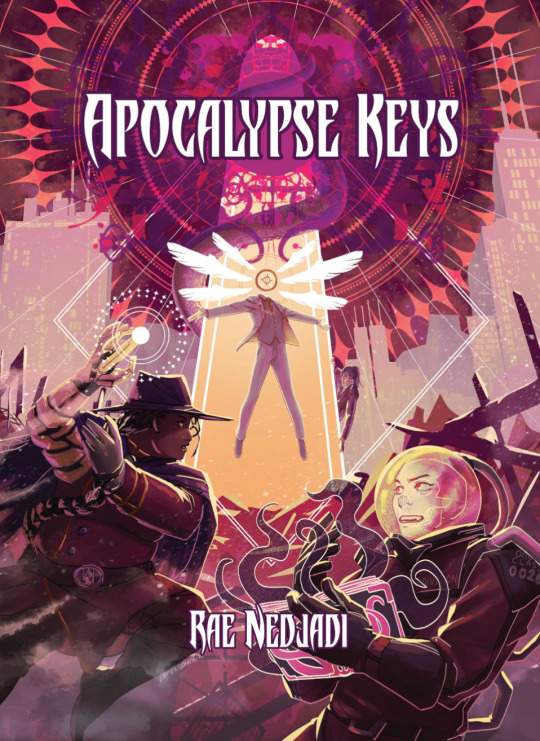



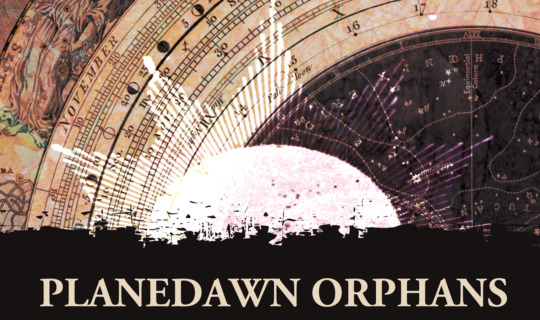
Fae’s Anatomy, by Hebanon Games.
Fae’s Anatomy is a comedic storytelling RPG wrapped around a challenging logic puzzle, recreating the high-stakes melodrama of medical procedurals like Grey’s Anatomy, House, and General Hospital.
Anybody can be an expert in Fae’s Anatomy. The game is set in a world where all forms of magic, spirituality, and mysticism are science. Science? Just another form of wizardry. Quackary, superstition, and pseudo-science work, but so does chemotherapy, antibiotics, and sound medicine.
In many ways, I’d say Fae’s Anatomy feels like a typical ttrpg: you have one person giving hints and clues to the rest of the players, who will use certain skills and abilities to solve a problem. But the closest role to the GM role - the Patient - is simply different from the doctors in what limits them. The Patient is suffering from some kind of mysterious illness, and while they have a little bit of information available to their general illness, the app presented to them to help them run through the diagnosis keeps the solution obscured enough to keep them on their toes. The Patient also has to role-play their symptoms well enough to help point the doctors in the right direction. In some ways, it feels like Fae’s Anatomy is an elegant form of charades - and if you want to hear how this game plays, you can check out the special episodes that Lawful Great Adventures recorded using this game!
Apocalypse Keys, by Rae Nedjadi @temporalhiccup
The Doomsday Clock is ticking down and emotions run high as you and your team of DIVISION agents struggle to find the Keys before the villainous Harbingers unlock the Doors of Power and bring about the apocalypse.
As an Omen class monster, you are the only thing capable of holding back the apocalypse. Combat occult threats and investigate supernatural phenomena alongside your team of supernatural agents working for the shadowy DIVISION. But in a world that shuns monsters like you, only your deepest, most heartfelt bonds can grant you the power to stop those who seek to unlock Doom’s Door.
There are two ways in which Apocalypse Keys uniquely empowers the players in ways I consider slightly unorthodox. Firstly, there’s the fact that the lore of DIVISION, the shadowy government agency that holds your monsters leash, isn’t fully fleshed out at the beginning of play. It’s slowly uncovered with each mission and playbook advancement, with the players being presented with questions and workshopping the answers together.
Second is the mystery mechanic, which was popularized by Brindlewood Bay and The Between, and also made its way into games such as External Containment Bureau and Bump in the Dark. While the GM designs clues and thinks about what kinds of Harbingers might be responsible for this specific apocalypse, it’s up to the players to decide what the answer to the mystery actually is - and it’s the player’s roll that determines how accurate they are.
Brinkwood, Blood of Tyrants, by Far Horizons Co-Op.
Mask up. Spill blood. Drink the Rich.
The world is not as it should be. The rich feed, literally, upon the poor, as blood-sucking vampires who barely bother to conceal their horrific, parasitic nature. The downtrodden peoples of the world struggle under the burdens of rent, payable through the sweat of their labor or the blood of their veins. Evil has triumphed. Many have given in to despair. But all is not lost.
In Brinkwood, you take on the role of renegades, thieves, and rebels struggling for freedom and liberation in a castylpunk world controlled by vampires. Radicalized by tragedy, you have taken up arms and fled into the forests, where you were taken in by unlikely allies - the fae, forgotten creatures of myth - who offered a different path and the means to fight back against your oppressors. Masks, forged of old wood and older magic, are the final tool left to fight a war long ago lost. If you wear them, they will take their price, etching themselves upon your very soul. But they will also let you spill the blood of the rich and powerful vampires that now rule the land, and from that blood strengthen yourself and your movement.
There’s a lot of things about Brinkwood that I absolutely love, from the way the mask playbooks are meant to be swapped among the characters/players with every mission, to the slow but steady revolution that you build by fostering connections with various factions in the Bloody Isles. But for the purpose of this request, we need to talk about Your Exquisite Fae.
Your Exquisite Fae is the process by which the group collaboratively creates a faerie patron, otherworldly and uniquely powerful. It’s inspired by the game Exquisite Corpse, which has each player draw a piece of a drawing without knowing what the others have already created. In Your Exquisite Fae, the players receive answers to prompts written by other players but aren’t given hints as to what the context was - and then they elaborate on what those answers mean. For example, one player might state that the Fae has eyes that reflect the night sky, gleaming like a thousand distant starts. The second player might decide that those eyes see the deepest fears of the enemy, giving the group an advantage at finding weaknesses and secrets when spying on vampires.
Ars Magica, by Atlas Games.
Ars Magica is the award-winning roleplaying game by Jonathan Tweet and Mark Rein•Hagen about wizards and their allies in Mythic Europe. This flexible, deeply built world can support games that are historically accurate or fantasy-based, epic or small scale, political or personal.
Players work together to tell the story of their covenant — all of the magi, their companions, and grogs. This history can span decades. It might be heroic, tragic, or both in turn. The covenant could influence the entirety of Mythic Europe or the fates of a small corner of the world.
Spells will be cast. Duels won and lost. Houses may rise and fall. But magic is forever.
The last time I talked about this game, one of my followers pointed out that this was an incredibly complex game that was designed to accommodate rotating GMs. The game styles itself as a troupe-style game, which means you’re not just responsible for your mages, but also your companions and servants. If you want a game with complex relationships and big-picture conflicts, this might be the game for you.
Slugblaster, by Mikey Hamm.
In the small town of Hillview, teenage hoverboarders sneak into other dimensions to explore, film tricks, go viral, and get away from the problems at home. It’s dangerous. It’s stupid. It’s got parent groups in a panic. And it’s the coolest thing ever.
This is Slugblaster. A table-top rpg about teenagehood, giant bugs, circuit-bent rayguns, and trying to be cool.
It may look like a small thing, but during crew creation, each character playbook has specific roles in determining the crew’s resources and relationships. The Grit picks a faction that trusts the crew. The Guts chooses a faction that the crew has somehow annoyed. Each player draws a portal between the known multiverses, but the Smarts draws two. The Chill has final say over where you hang out when you’re not Slugblasting, and The Heart has final say over your crew name.
I’ve drawn direct inspiration from this setup in my own game that I’m playtesting, by giving each playbook final say over some element in the world, and I think it really boosts player agency and gives them control over the kind of story the group wants to tell.
Planedawn Orphans, by Sharkbomb Studios.
Planedawn Orphans is a campaign kit that helps you prepare a campaign for the fantasy role-playing game of your choice. It provides a flexible and versatile framework to start a campaign. The campaign kit will help you get started and provide structure and support, but some assembly is required.
Set in the Planar City, a strange melting pot that connects the vast diversity of the multiverse. You all play Planar Orphans stranded in this city, your original home worlds destroyed, corrupted or lost. A mysterious Patron has brought you together, provided you with a base of operations and tasked you to complete a Planar Key. This key will let you create a new plane for you and your fellow refugees. Your quest will bring you to exotic places filled with strange creatures and bizarre phenomena.
This isn’t a standalone rpg, but rather a campaign kit for whatever system you like - or even multiple systems! I’m recommending this toolkit because I’m actually planning to use it to run a series of rotating-gm games later this year, with a friend of mine. You’re building your own custom dimension by jumping into a series of vastly different worlds, and your home base is built collectively. There’s a lot of player agency and GM agency here, as players have plenty of control over their home dimensions (since they can’t ever go back) and the GMs can take turns designing custom worlds for the party to jump into. I definitely recommend checking it out.
Also Check Out
Asymmetrical Games Rec Post
#rotating gms#unique player responsibilities#tabletop games#indie ttrpgs#dnd#game recommendations#asks#indie ttrpg
185 notes
·
View notes
Text
How To Create And Execute Unreliable Narrators
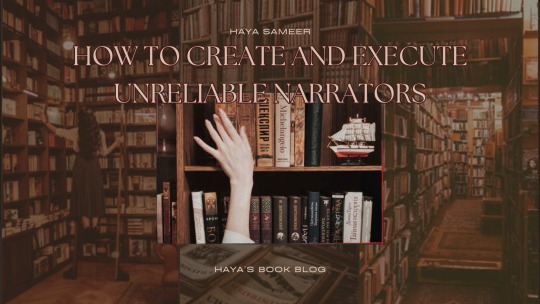
Unreliable narrators are a powerful literary device that adds complexity and intrigue to a narrative. You've likely encountered them in classic novels like "Lolita" or contemporary hits like "Gone Girl." These narrators keep readers guessing, challenge perceptions, and add layers of depth to the story.
Throughout this blog, we'll explore the ins and outs of unreliable narrators, from what they are to how to effectively craft and utilize them in your writing.
Understanding Unreliable Narration
Unreliable narrators come in various forms, each with its unique charm. To effectively create and execute them, it's essential to understand the different types. Here are the primary categories:
Intentionally Deceptive Narrators: These narrators consciously lie, mislead, or omit vital information to manipulate the reader's perception. They have a hidden agenda, and their unreliability is deliberate. Think of Amy Dunne from "Gone Girl."
Psychologically Unstable Narrators: These characters suffer from mental or emotional issues that affect their judgment and perception of reality. Their unreliability stems from their mental state, like the protagonist in "The Catcher in the Rye."
Naively Mistaken Narrators: These narrators are innocent and well-intentioned but misinterpret events or are too young to fully grasp what's happening. Scout Finch from "To Kill a Mockingbird" is a classic example.
The impact of an unreliable narrator is profound. It challenges readers to question, analyze, and engage more actively with the text. It adds complexity to the storytelling and often leads to a more profound understanding of character motivations and the narrative's depth.
Creating Unreliable Narrators
Now that we've laid the groundwork for understanding unreliable narrators, let's dive into the process of crafting them. To create an unreliable narrator, you'll need to focus on character development and the careful use of narrative techniques.
Character Development:
Establish Background: Begin by creating a detailed background for your narrator. Understand their history, experiences, and personal motivations. Knowing your character inside and out will help you determine what might lead them to unreliability.
Motivation for Unreliability: Consider what drives your narrator to be unreliable. It could be a desire to hide a dark secret, protect someone, or gain an advantage. Their motivation will shape the way they deceive or misconstrue events.
Techniques for Revealing Unreliability:
Inconsistent Narration: Use shifts in perspective, varying accounts of events, or contradictory statements to signal unreliability. Readers should sense that something isn't quite right.
Unreliable Dialogue: Craft dialogues in which other characters react to or question the narrator's claims. This can help reveal the narrator's unreliability indirectly.
Internal Monologue: Offer glimpses into the narrator's thoughts and emotions, revealing their true intentions or doubts about their version of events.
Creating an unreliable narrator is a balance of providing subtle clues to the reader without giving away the full truth too soon. It's like constructing an intricate puzzle with pieces that fit together in unexpected ways.
Executing Unreliable Narration
Crafting an unreliable narrator is just the beginning; executing their character effectively is where the magic happens. Let's dive into strategies for maintaining suspense and intrigue surrounding your narrator's unreliability:
Strategies for Execution:
Gradual Revelation: Don't reveal the extent of your narrator's unreliability too early. Gradually introduce inconsistencies, contradictions, or hints that make readers question the narrator's perspective.
Conflicting Perspectives: Present events from other characters' viewpoints to show the disparity between what the narrator believes and what's happening in reality.
Trust vs. Doubt: Create a delicate balance between moments where readers may believe the narrator and moments that cast doubt. This ebb and flow keeps the suspense alive.
Unreliable Perception: Use the narrator's own perceptions and biases to create an alternative version of reality. Their interpretation of events can be vastly different from the objective truth.
Examples from Literature:
To gain insights into executing unreliable narration effectively, let's turn to literature for inspiration:
"The Girl on the Train" by Paula Hawkins: This psychological thriller employs multiple unreliable narrators to keep readers guessing about the true events of the story.
"Fight Club" by Chuck Palahniuk: The protagonist's unreliability is brilliantly executed as his split personality blurs the line between reality and delusion.
By carefully implementing these strategies and drawing inspiration from well-executed examples, you can keep your readers engaged and invested in deciphering the truth behind your narrator's unreliability.
The Reader's Experience
The beauty of unreliable narration lies in the reader's role in uncovering the truth. Readers become detectives, piecing together the puzzle of the narrative, challenging their assumptions, and engaging in critical thinking. Here's how the reader's experience plays a vital role:
Critical Interpretation: Unreliable narrators encourage readers to question everything they're told. It invites them to look for subtle clues, contradictions, and alternative explanations.
Reader Engagement: Readers actively engage with the story, forming their theories and interpretations. This interactive element can lead to lively discussions and debates among readers.
Psychological Connection: An unreliable narrator often reveals truths about human nature, memory, and perspective. Readers connect with the character's psychological journey on a deeper level.
Personal Discovery: The "aha" moment when the reader unravels the narrator's unreliability is a unique and rewarding experience.
The reader's experience is a fundamental part of crafting an unreliable narrator. It adds depth to your storytelling and encourages readers to become active participants in the narrative.
Common Pitfalls and How to Avoid Them
Crafting an unreliable narrator can be a thrilling creative endeavour, but it's not without its challenges. Here are some common pitfalls to be aware of:
Overuse of Unreliable Narrators: Using unreliable narrators in every story can become predictable. It's essential to employ them when the story genuinely benefits from the unreliable perspective.
Inconsistent Characterization: Be consistent with the narrator's unreliability. Avoid having them switch between deception and clarity without reason. Readers should sense a pattern to their unreliability.
Frustrating Readers: While keeping readers engaged is good, frustrating them to the point of losing interest is not. Balance the revelation of truth and deception effectively.
Overly Complex Narration: Unreliable narration can make the story more intricate, but don't make it overly complex to the point where it becomes confusing.
Revealing Unreliability Too Late: Waiting too long to reveal the narrator's unreliability can lead to reader disengagement. Provide enough hints to maintain their curiosity.
To avoid these pitfalls, remember that the key to successful unreliable narration is balance. Give your readers the right amount of information, trust, and doubt to keep them engaged without overwhelming them.
Now that we've explored the nuances of creating and executing unreliable narrators and learned how to avoid common pitfalls, you're well-equipped to embark on your own literary journey using this fascinating narrative technique.
I hope this blog on How To Create And Execute Unreliable Narrators will help you in your writing journey. Be sure to comment any tips of your own to help your fellow authors prosper, and follow my blog for new blog updates every Monday and Thursday.
Looking For More Writing Tips And Tricks?
Are you an author looking for writing tips and tricks to better your manuscript? Or do you want to learn about how to get a literary agent, get published and properly market your book? Consider checking out the rest of Haya’s book blog where I post writing and publishing tips for authors every Monday and Thursday! And don’t forget to head over to my TikTok and Instagram profiles @hayatheauthor to learn more about my WIP and writing journey!
#hayatheauthor#haya's book blog#haya blogs#writers on tumblr#writer community#writer tools#writer blog#writer stuff#writer wednesday#writer tips#creative writing#writers of tumblr#writerscommunity#writeblr#writing community#writer spotlight#writer things#writing prompt#writing tools#writing stuff#writing#writing life#writing inspo#writing help#writing advice#writing inspiration#writing ideas#writing things#writing tip
245 notes
·
View notes
Text
OMORI AND STORYTELLING THROUGH CHARACTER DESIGN
I’ve been thinking about this for a while and I think it’s a very fun detail to over analyze.
SPOILERS AHEAD‼️‼️‼️
HEADSPACE
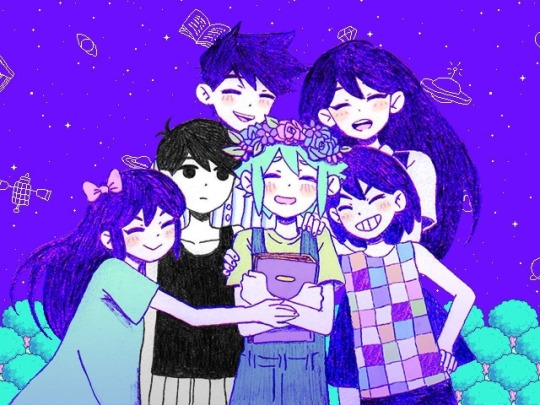
Upon first meeting the headspace gang Omori and Basil stand out very sharply. Omori with his lack of color, and Basil with the unique color of his hair and eyes. The two are clear foils; Omori is silent and keeps himself as far from focus as possible- While Basil is the group glue and focus before and after his disappearance.
Through the character designs and personalities, we are primed to connect and focus on Basil rather than Omori. Basil is pastel colored, a pacifist and a lover. Omori’s vacant eyes and silent knife-wielding nature are less inviting. Very often with RPG horrors, silent protagonists are overlooked in favor of supporting cast. Omori actively uses this as an aspect of its story. We’re supposed to focus on Basil- Sunny is supposed to focus on Basil
THE HORROR
This all lends to our first bait and switch- and our first of Basil’s complex role in the narrative.
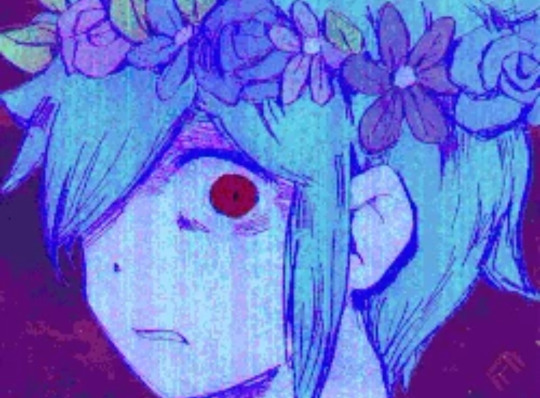
Basil is our first glimpse into the horror themes of Omori- and this actively betrays the players trust. Again- Basil was our lovable safe character- We are primed to trust him. Then everything goes wrong (Sounds familiar).
The red eyes are obviously unsettling- again, betraying our trust by subverting the innocence of Basil’s appearance.
Furthering this! With Basil’s disappearance arrives Stranger
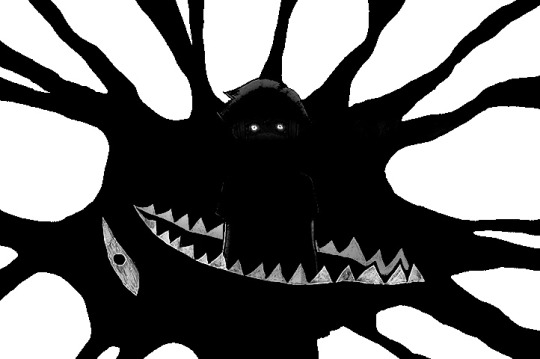
A shadowed figure resembling Basil leaving bloody footprints- Basil’s design has been completely subverted into something known and comforting- to a Stranger.
Omori and Stranger are an inverse of Omori and Basil’s design foils. Omori is white with black accents and eyes. Stranger is a full black silhouette with glowing white eyes. And they are of course just as much personality foils. Omori is danger and escapism under an innocent mask. Stranger is a frightening and cryptic individual who only aims to help Sunny. The bloody footprints are foreboding and unsettling- But they’re guides helping Sunny.
Adding on to this, Stranger and Omori’s design’s aren’t foils in the way of being opposites- they’re foils in the way of being compliments. They’re reflections of black and white- two sides of the same coin.
REAL WORLD BASIL

The introduction of real world Basil once again subverts previous expectations- I think for both the audience and Sunny. Setup as foils- opposites throughout the entirety of headspace, the Real World Basil and Sunny could not be more similar design wise. Their outfits are near identical; and their pale frail physiques are the same- even down to the height.
Despite everything set up in Headspace- Basil is by far the character most similar to us in Faraway town. As much as Sunny tries to deny it in his mind- he and Basil were heavily shaped by their shared history. They’re not opposites. Both have become reclusive in the days since Mari’s death, they both lost connections with the group, and both are riddled with guilt, fear, and self loathing. Sunny tries so hard to sever his connections to Basil in his mind, they’re in the exact same position.
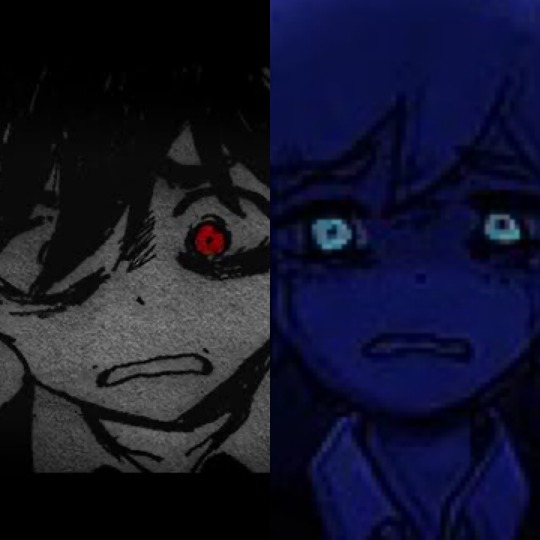
Through the final fight with Basil, all of Sunny and Basil’s parallels are put to light. Both in the same clothes, living with the same crippling fear of what they both went to together. Both of their Somethings heightening their fear and crippling any rationality. Basil’s weapon- garden shears are an easy parallel to Omori’s knife.
Their only major design difference is their eyes and hair. Sunny’s eyes still their empty black (or sharp red when stressed out) and Basil’s an eerie glowing blue. Even if they’ve developed in the same circumstances, the two have reacted very differently because of their personalities. Sunny avoidant and stoic, Basil desperate and erratic. Once again, the two are complimentary foils. No matter what form Basil takes, he and Sunny are tied together as reflections of one another, and the shared experiences that molded them.
BONUS- HIKKIKOMORI
In the Hikkikomori route you fight Stranger instead of Real life Basil. The Hikkikomori route illustrates a complete refusal from Sunny to acknowledge the truth of the incident, and this means erasing Basil as a person. Destroying every one of these parallels I’ve discussed.
Basil and Stranger lose their depth. Basil is resigned to the picnic basket with Mari and kept out of the way. He’s lost his right to focus and autonomy, rather staying a shallow memory vague enough to protect Sunny’s repression.
Stranger is treated as an enemy. He is solely Omori’s opponent and will be eliminated as such. All of Basil’s complexity wiped away with his death. Leaving that cardboard cutout- Headspace Basil.
Furthermore, the fight with Stranger (obviously) has direct parallels to the final fight with Basil. Basil and Sunny wear their identical clothes and fight as two parallels. Stranger and Omori are black and white enemies, as Omori refuses to acknowledge Basil’s connection and similarities to Sunny. He refuses the complexity Stranger represents.
81 notes
·
View notes
Text
The "What if the Traveler is Jack's Dad?" Dilemma & The Power of Character Design in Just Dance’s Storytelling
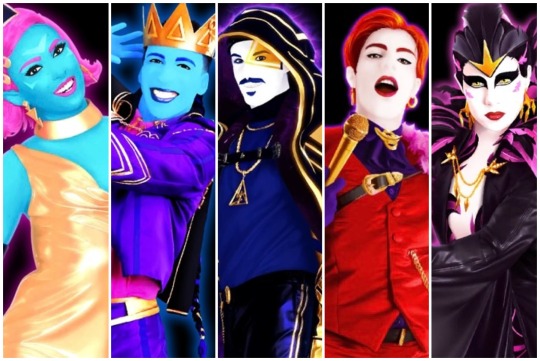
Originally I had an entire post of all of my thoughts on the worry that the Night Swan event will confirm that Jack's father is the Traveler, but this part made up well over half of it, so I made it a post of its own. I might post the rest separately at some point (I don't even know if I actually think that Ubisoft will make it canon, but I did this anyway).
I went a little crazy on this one, but stick with me here. I am well aware that people don't have to look anything like their parents, but in the world of things like video games (and especially in a game that has to rely entirely on visuals in the absence of dialogue), it's not a bad idea to make related characters visually similar enough for the audience to put their relation together, and the Just Dance team has done an excellent job of this with Wanderlust, so I thought I'd do some analysis on it in relation to the "Jack is the Traveler's son" theory we're all so worried about. This is a very long post - you have been warned.
Disclaimer of sorts: I'm not a costume designer. I'm not a character designer. I'm a musical theater composer, though, who has worked closely with artists on costume design, and I like to think that I have a pretty decent handle on the basics of visual storytelling through character design, which is what this entire post is based off of.
(This post also contains a small spoiler for Sweet Dreams, though it seems that it won’t be a beta for much longer…)
One of the cool things about Wanderlust's appearance is the way that the designers managed to give him his own unique look while also paying homage to both of his parents. It's important to note here that both Si'ha Nova and the Traveler were already well established characters by the time of Wanderlust's first appearance in JD23, so it was important to give him those visual similarities to make his connection to them more apparent.
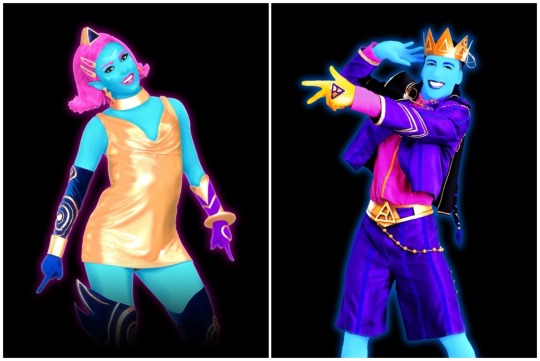
The most obvious visual similarity between Si'ha and Wanderlust is their blue skin, which makes it pretty clear upon first glance that they're related. A non-genetic but still obvious visual similarity between the two is the use of triangle motifs. Si'ha has one on her head and more on her earrings, for example, while Wanderlust has them on his crown, one on his glove, and one on his belt. I think that it's also worth noting that the golden accents on Wanderlust's sleeves are vaguely reminiscent of the ones on Si'ha's purple glove. They both also have purple, gold, and pink in their overall designs.
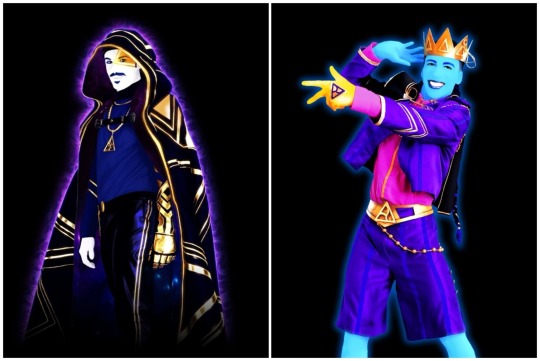
Wanderlust has fewer “genetic” visual similarities with his father than he does with his mother, but they're still there. The only "genetic" similarity that they really have is the blue hair (granted, Wanderlust's is only a streak of blue, but it's still there, and his eyebrows are blue, as well). They have a ton of other visual similarities in their designs, though. Just like Si'ha, the Traveler has several triangle motifs throughout his appearance. The one he wears on a chain around his neck is very similar to the one on Wanderlust's glove and belt. They both have their own unique triangle symbols, but they're quite similar. Also notable is Wanderlust's half-cape, which is dark with gold accents, much like the Traveler's cloak. Once again, those gold lines on the Traveler's cloak are similar to the ones on Wander's sleeve. Additionally, Wanderlust seems to have the same eye color as both of his parents.
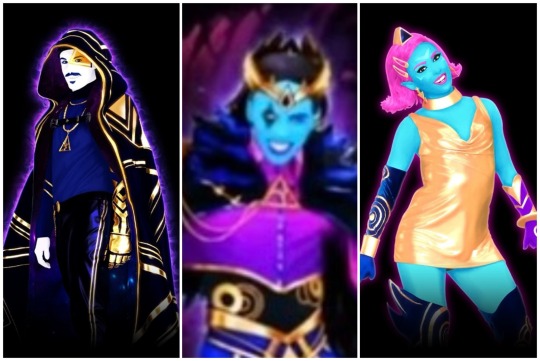
Even when he's been transformed by Night Swan's spell, Night Wanderlust (or, as I like to call him, Swanderlust) has several visual similarities to both of his parents that he doesn't have in his "normal" form. Though not the same shape or color, he has a shape over one of his eyes like the Traveler does, and those shapes on the black part of his shirt are, to me, very reminiscent of the circles on Si'ha's blue glove. And that little triangle on his crown is remarkably similar to the one on Si'ha's head, black surrounded by gold (I also think the blue of the feathers on his cape are similar in color to the Traveler’s shirt).

I know that Sweet Dreams is a beta (though it might not be for much longer) and that it's very possible that if they do release it, they might change this shot, but for now, I want to use it. When I first saw this shot of Night Swan at the end of Sweet Dreams, I was really thrown off because something felt very wrong with it, and I realized that it's her eyes. They are such a bright green here. It felt like such an intentional choice, and it made me think of the fact that all of Jack's avatars (though you can see it most clearly in his legendary avatar) have green eyes. Does he have green eyes in the actual game? No. But I thought it was an interesting enough detail to include here. Personally, my headcanon is that Night Swan had green eyes before she became Night Swan, at which point they turned yellow, meaning that her eyes are naturally green and that she passed that trait on to her son.
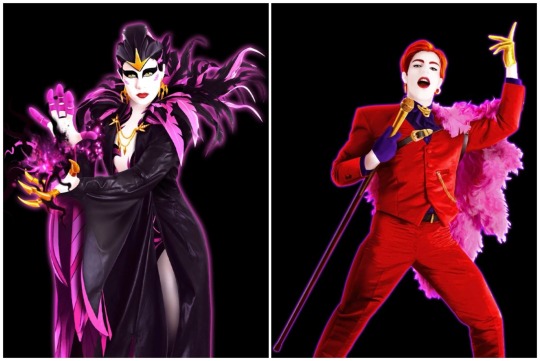
Though they're rather lacking in "genetic" similarities, though, Night Swan and Jack have plenty of those visual similarities that Wanderlust has with his parents (I also think it's worth mentioning that, save for that one teaser in Season 1: Astral, Night Swan and Jack were introduced in the same game, meaning that the need to make Jack as visually similar to her isn't necessarily as important, because Night Swan isn't an established character like Si'ha and the Traveler were prior to Wanderlust's appearance). The pink feathers are an obvious visual similarity between the two. They also both wear gold earrings and have a golden chain (Night Swan on her coat and Jack hanging from his pocket), and Night Swan's golden claws are represented by the golden glove on Jack's hand.
I also want to throw out there that Wanderlust is the son of two "good" characters, and his visual similarities to them indicate that he has that same "goodness." Jack, on the other hand, is the son of a villain, and making him stand out from his mother visually is a good way to represent from the start that he's supposed to be a sympathetic character who isn't anything like his mother. Because it's a dancing game, we don't get any sort of dialogue from him that could indicate that he's not a villain, so we're left to rely on his expressions (which Mickael did a fucking phenomenal job on) and his overall design. Making him stand out from his mother visually is a good way to show us from the start that he's not inherently on his mother's side.
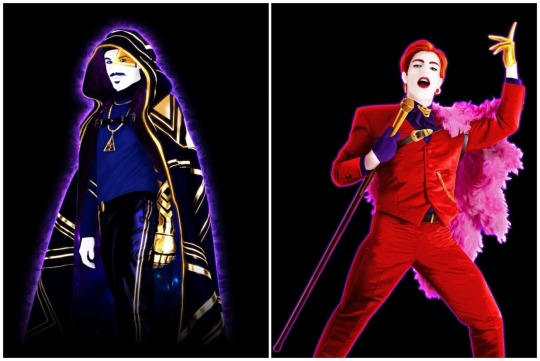
Assuming the Traveler is Jack's father, there is essentially no similarity between the two save for the inclusion of some gold accents. I would say they have the same eye color, but I feel like Jack's dark eyes are overridden by the green eyes in all three of his avatars. Granted, it makes sense for Jack's appearance to be influenced by his mother considering she's the one who raised him, but I think that, from a storytelling perspective, it would have been a smart move to include some semblance of a visual similarity between Jack and the Traveler if they had really intended from the start for the Traveler to be Jack's father. If they did intend on this being a plot point from the start, they intentionally kept it a secret by not including a single visual clue, which is, to me as a storyteller, a sort of annoying thing that makes it seem like they’re more focused on pulling the rug out from under the audience than they are on making sure that the plot twists make sense. But hey, that’s just me.
If you actually, read all of that, I love you and you are the best and thank you for actually taking the time to read my ridiculous rambles. I hope it was at least mildly interesting and made some decent points.
#just dance#just dance theory#just dance 2022#just dance 2023#just dance 2024#jd si’ha nova#the traveler just dance#wanderlust just dance#wanderlust jd#jack rose just dance#jack rose jd#night swan just dance#night swan jd
68 notes
·
View notes
Note
I just wanted to let you know that I just found your tumblr within the past week and you have immediately become my 2nd favorite tumblr, being only behind Blogatog. Love your ttrpg takes.
Anywho, you said to ask about flags, so what is your biggest/are your biggest red flags when it comes to ttrpg design?
thank you! i'm glad you enjoy my silly little posts. anyways i think my biggest red flag is unintentionality--the feeling that the writer of a TTRPG has done something by 'default', the inability to put myself in their shoes and understand (or even better, be told by the text itself) the reason why a particular decision has been made.
one of the biggest places this rears its head is in terms of tone and voice. let me quote jay dragon's really good the storyteller technique:
Another advantage of getting to know the narrator of your RPG is that it helps mitigate unconscious bias in your design. Dungeons & Dragons has a notably anthropological narrative voice, explaining other cultures and creatures like a scientist in the field. The language of D&D mimics the writing style of mid-century scientists traveling to “exotic” locations and cataloging non-Western experiences as part of a documentation of the Other. It’s easy for newer designers to want to “write a game like D&D” without regard for how even the narrative voice of Dungeons & Dragons carries unintended political baggage. Is a bird’s-eye and judgemental perspective really the energy you want to bring to your whimsical fantasy world? Or is there another perspective within your world that can be more useful, and allow you to find new perspectives on the world you’ve created.
narrative tone is a choice--the attempt to use a 'neutral' tone for rules text and description is also a choice, how formal and how informal you get with it is a choice, and when i read a text that seems to have made that choice thoughtlessly it imo bodes very poorly for the rest of the game.
other examples of this kind of unintentionality are games that have a comabt system despite not being about combat in any way--games with equipment rules despite them not setting out to tell the sort of story where which sword or gun a character has matters--games that measure themselves in exact distances without actually using a battlemap--&c.
while most of this unintentionality takes the form of 'falling back onto what DND does' because DND is the market leader and many people's first TTRPG, so imitating it without purpose is something that both cynical market-share chasers & unexperienced designers without a wide range of expereicne can do--it's absolutely not unique to it. one form of unintentionality i see a lot in indie TTRPG circles is creating far more Moves for your PBtA game than necessary--clearly more out of a sense that 'AW/MotW/Masks has a Move for this' than any specific understanding of what that move will do in your game
in game design--as in any art--there is no such thing as a 'neutral' choice or a non-choice. there are only choices, and how much someone's thought about these choices is important!
358 notes
·
View notes
Text
ORV EPILOGUE SPOILERS.
Okay so I made a random ramble thread on twitter about my ORV Epilogue headcanons/interpretations and it's become apparent to me that. Uh. My perspective is somewhat unique so here:
ORV Epilogue is a huge callback to the Disaster of Floods, and a certified Disconnected Film Theory™ moment.
When the system starts to regain power and reactivate, one of the first things said (by HSY), as the stories start to reform is "Disconnected film theory?!" and my IMMEDIATE thought was this:
This phenomenon was activated because we, aka a Kim Dokja of a different timeline, have met him through our reading of the story, and through this, KDJ regains his memories. The parts of ourselves that came directly from KDJ such as loving this story and the characters, or perhaps our own "memories" of him that were formed by the act of reading ORV.
Because why else mention DFT specifically? The fact that the systems have restarted and the storytelling is continuing were enough to signal that Kimcom's efforts could have worked, that they've successfully gotten the story out, and KDJ's fragments to wish for his return...
But DFT being mentioned naturally made me think back to its introduction, where it is most prominently utilized: the Disaster of Floods, where the two Shin Yoosungs started to have their memories, their 'films' mixed up...
Kim Dokja used his First Person POV skill at this point, and viewed the world through 41st Shin Yoosung's eyes.

DFT's initial stake in this scenario is that it's there so that, when active, if you killed one timeline's version of a character, the other one would also die, thus the party's dilemma as to whether to spare the child Yoosung. And later on, it activates when he meets the Oldest Dream...
But THIS film-related memory-fuckery also stuck out to me. Not only that... I feel like it might be implied that this happens because of an outside force: Kim Dokja.
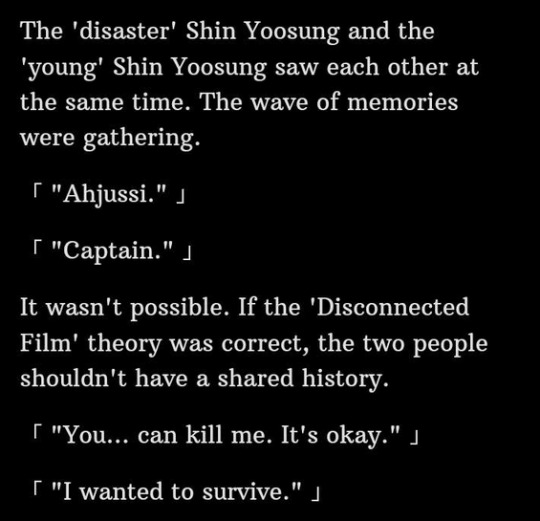
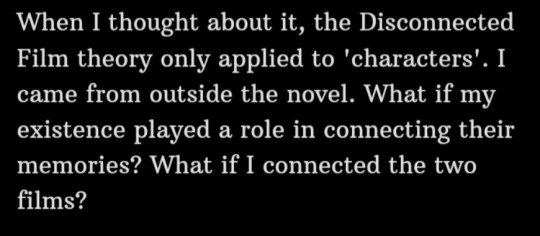
Are you still with me. Okay. Two more things:
Why call back to the Disaster of Floods? If not to also remember how, in this scenario, the wishes of the Constellations [thus, readers] wrote the ending?
Aren't we, the reader, a fragment of Kim Dokja, the outside force in this situation?
Haven't we been using the same skill as Kim Dokja the entire time?
also, Disaster of Floods happens relatively early on, so it just scratches my story structure itch if it comes back as a bookend.
tl;dr basically. We brought him back. And we gave him back his memories.
Through the combination of 1. our imagination, our wish for KDJ to wake up, and 2. our own memories entangling with KDJ's through disconnected film theory.
DFT, in turn, activated because 1. we are him from a different timeline and 2. met him through the story that 3. kimcom busted their ass to deliver to us <3
#orv#orv spoilers#orv epilogue spoilers#orv meta#omniscient reader#omniscient reader's viewpoint#kim dokja#kdj#i'm not crazy right. like. this tracks right.#i have only read orv once and only skimmed the relevant passages so. shrug!!!!#not art
60 notes
·
View notes
Text
TSP FERNATOR THEORY – THE ROLE OF NATURE IN THE STANLEY PARABLE
Oh gosh, I took this so seriously but hope someone will enjoy my rambling ;w; Just will say it here - this essay is game interpretation, it doesn't talk about Fernator AU (only mentions it).

Contents
0. What is Fernator AU?
“Stanley, this fern will be very important later in the story.” (Confusion, Bucket Destroyer & Figleys Endings – Fern)
“It's all out of my control now.” (Skip Button)
“Yes, I have something very exciting to show you!“ (TSP 2 Expo)
“And Stanley was happy.” (Outdoors - Freedom Ending and Memory Zone)
“The office could use a bit of decoration.” (Other plants in-game, Games Ending, Epilogue)
Conclusions
(Click 'Read More')
0. WHAT IS FERNATOR AU
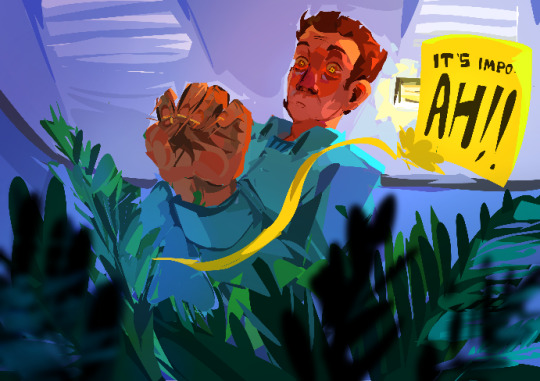
Fernator AKA Fernnarrator AKA Fernie is my TSP AU where the Narrator takes the form of the Fern and gets moved into the Bucket.
His form can change into any plant, either through a conscious decision or subconsciously, based on his emotions. While some of his flowers blooming can fit the conventional flower language, he creates his own based on his own bias for the plants.
The AU isn’t purely cosmetic – depending on his and Stanley’s relationship before the discovery of Narrator being the Fern, it splits into 3 main pathways.
Each one of them has different ending alternatives and on top of that, the AU has a linear story.
This post will NOT be focusing on Fernator AU - instead, it will talk about the plants of the Parable and my theories about their meaning. These do influence Fernator AU as a whole but I will leave AU talk for another time if anyone would be interested.
Instead, let’s talk about the two main inspirations for the AU: Fern and The Skip Button.
1. “STANLEY, THIS FERN WILL BE VERY IMPORTANT LATER IN THE STORY.” (Confusion, Bucket Destroyer & Figleys Endings – Fern)

This Fern is one of the few plants in the game and the only one mentioned in dialogue.
Its placement in the Confusion Ending is a set-up for a joke: something gets mentioned, said to have a big importance and then gets forgotten.
Maybe that was its whole purpose - a gag about misplaced foreshadowing or there is more to it.
A reverse situation is the Broom Closet – it can represent the “show, not tell” rule in storytelling where an object isn’t mentioned through text but more through actions. Narrator is displeased with that and on the third reset in a row after interacting with it, the Closet gets temporarily boarded.
That changes in the Bucket version– you can come in it as many times as you want and Narrator doesn’t get mad at Stanley (which overall is a theme in post-Skip).
So, these two are a perfect contrast:
Narrator doesn’t even mention the Broom Closet at first. However, it ends up getting new unique lines and gives long-term effects on the story (boarding the door).
The Fern gets mentioned in the story but doesn’t show up later in the ending.
However, the plant does appear in the alternative of Confusion – the Bucket Destroyer Ending.
“We're the ones that matter Stanley! Classic characters from the first game.”
Each of the objects in this picture symbolises a person in Stanley’s life:
the Broom Closet = Player, since in the original version, if you stay longer, Narrator talks about them;
the pencil sharpener= 432 – in lore, madness through never being given a pencil to sharpen;
Stanley’s computer= Boss, due to the orders;
Wife mannequin;
Baby cut-out (might also represent Stanley’s kids);
Adventure Line ™ – it isn’t a person but is said to be conscious;
and the Fern.
(EDIT: Beau in Stanarr server also said that the mugs on the table could symbolise the Employees while the Baby could be The Essence of Divine Art. That could potentially mean that Adventure Line™ could also symbolise curiosity - just like, while TEDA seems to be a conscious being, might just be human creativity. )

We already have the Line ™ from the Confusion Ending. Other objects could have been used for this scene but somehow, it is the Fern that ends up being showcased. It could be just due to it belonging to this pathway but it could be also something else.
“You see, your friends and I are concerned for you, Stanley.”
He could be meaning himself just as the voice – after all, the separation between him and his friends is not that uncommon. He does use the word ‘friend’ positively only in the UD version of the game. He calls Stanley his friend only once and then, proceeds to call the Bucket and Stanley friends a few times, making it obvious the man projects on that object.
Here though, Narrator is against the Bucket - so, why couldn’t he start to project on something else? That way, he could visually show the group of friends with himself.
So you know,,, Fernator real,,, maybe,,,,,,,
(Big thanks to Chris from Crowsx3 Discord for reminding me about this next part)
I was also reminded that Fern makes one more appearance - in the Figley Ending, Confusion Ending room.

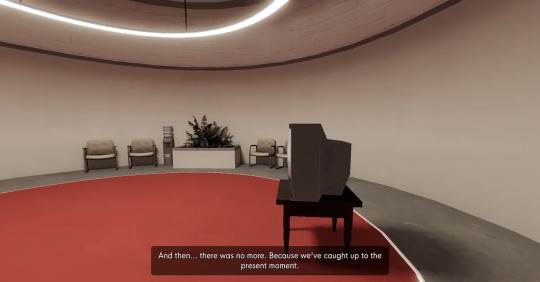
You get to this room after a Red-Blue door choice that doesn't matter at all, leading to an open door. It perfectly blends so many parts of the game together - the choice between two pathways, the illusion of the choice and also brings something new - backtracking.
In most of the game, we are unable to do so - the doors close behind us and that's it. But, just like in Confusion - Narrator wants to backtrack, to change the pathway, for one last adventure with Stanley.
Maybe that was the importance of the Fern. For it to show up when Narrator wants to do something fresh, something new, WITH Stanley.
"Oh, I want more memories, Stanley! I want to keep going!"
In the end, he wants to retire and move on. If he does and only leaves his recording, if he stays with everything TK has done - that's up to a debate for another time.
But one thing is known - we all remember the Fern, even if it doesn't heavily impact the story.
Unless you know - Narrator took the form of it and then-
Ok ok, but this was the nice task – now let’s talk about The Skip Button.
2. “IT'S ALL OUT OF MY CONTROL NOW.” (Skip Button)
I will talk about the Memory Zone later – here, I want to focus solely on the Skip Button room.

The Skip Button plant is the only thing in the Parable that shows actual ageing. Sure, there are some other symbols of time passage - i.e. clocks, and scratches on objects but nothing else shows decay besides this one single plant.
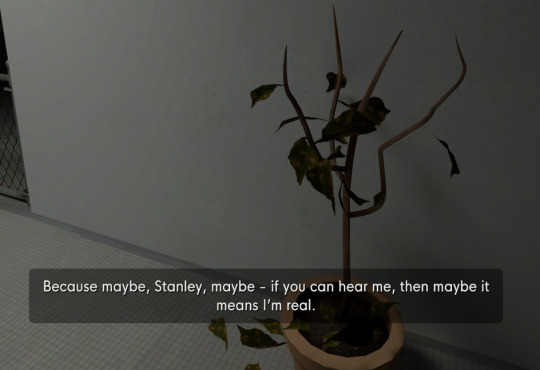

Changes happen in Skips #5 and #6.
In Skip #5, Narrator says it’s been a week or two.
I know that people have done the math on how much time passed through each skip takes but we will base it only on the plant alone. While a week is too short for a plant like that to show signs of severe dehydration, 2 weeks is more plausible.
In Skip #6 - when he says he had stopped counting once it was over a year - the plant is dead.
Death is overall a bit of a theme in the Parable – the Countdown, Museum, Apartment and Zending especially have a lot of lines about Stanley’s death, which should cause permanent effects. Instead, the game just resets, not making any deal about it.
This plant, however, does not return to its original form.
In Skip #13, concrete falls on it, leaving the plant trapped for the rest of this pathway.
I think the room overall (together with the plants and the clock) symbolises Narrator’s psyche.
The first few Skips are alright for him - sure, the time in-between seems to grow but he still thinks it is a good idea. He starts to panic and begs Stanley not to press the button in Skip #4 and in Skip #5, both the plant changes and the lights dim down. This is when he has been left for those two weeks all for himself and just sounds so tired - and with each skip, another part of his psyche breaks.
The clock stops working and falls around #8 and #9. It’s still long since in #6, Narrator where he says he lost count but he might have just exaggerated it, only losing it in these runs.


After such a long period in solitude, any mind would start to decay - the plant, the pipes letting the water escape through them, the fire alarm going off (since batteries are low), the walls getting destroyed with time… Together with how silent Narrator gets at times, I genuinely believe this whole section is us being in his brain.
But then in Skip #15, (after the sunlight in #14) this happens:

These skips are special because they are a glimpse of hope. Sunbeams, birds chirping, new life in the form of plants showing up – just for it all to disappear next Skip.
While the last time we hear Narrator talk is in #11 (The end is never), this feels like he is trying to talk to Stanley indirectly. The destruction of the ceiling feels like an attempt to break Stanley free, which, unfortunately, was a bit misplaced since we don’t have the jump option (curse you, jump circle for gatekeeping them / silly).
These can mean several things.
Narrator hopes that the situation would soon end, as mentioned in the previous part.
It could also show that he is making new ideas and growing. I think it would be a poetic way of personal growth. It is visible in the Bucket version of the game - lack of Red-Blue doors, Countdown becoming silly birds ending, him calling Stanley his friend through the bucket - he wants to change for the better.
“You are not beyond redemption. You may change, and you may become more, so much more than you were before.”
And what better way to show that than through physical growth?
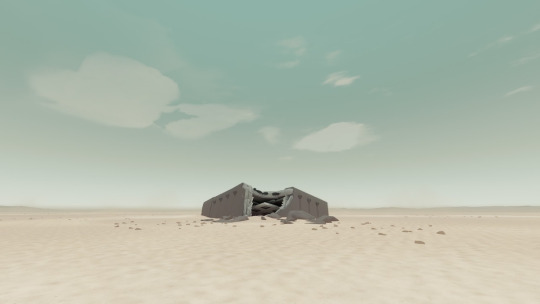
Even if his mind, in the end, becomes the sandy landscape we all know - he had tried to get better and, in some way, succeeded.
I sometimes wonder if the New New Content & Bucket parts of the game are what Narrator wants to turn the game into during these Skips. How he wants to acknowledge Stanley, show that he cares for him and that he matured.
But, let’s go back a bit. The New New Content happening during these skips in Narrator’s mind are a cute theory but, it’s just that - a theory.
What is real though is the game content, like the plants in the TSP 2 Expo.
3. “YES, I HAVE SOMETHING VERY EXCITING TO SHOW YOU!“ (TSP 2 Expo)

This part alone has 4 new plants that were never seen before in the rest of the office (they later make an appearance again in the Bucket Apartment Ending).

Three of the plants have some resemblance to the one in the Skip button - a long office plant put in a pot, while the smaller ones seem similar to the Fern.
(Small note: these plants are based on real-life ones that are common in offices and are low maintenance but I am too tired to figure out their types.
Possibilities from a bud: “the first one in the basket is prob Dieffenbachia Seguine, down in middle is calathea makoyana, low right kentia palm”. )
Interestingly, the whole Expo is red-themed so, to compliment that with the opposite colour - green - could seem like it’s a bolder move. It to be fair isn’t - there are a lot of greys, whites and browns that tie everything together, not letting this become a Christmas-themed event.
Expo gives us a lot of new and fresh Narrator ideas - the Bucket, Figleys, and Infinitive Hole. I think these plants also deserve a mention - they all tie perfectly to the theme of Narrator’s growth.
He wants to be better, to please Stanley and I think, maybe, to fit in more. He could have reused the same plant from the Office but no - he made new ones.
And just like the Broom Closet - they never get acknowledged in the dialogue.
Show, not tell.
4. “AND STANLEY WAS HAPPY.” (Outdoors - Freedom Ending and Memory Zone)
Stanley felt the cold breeze, blablabla, you know the drill by now. Most of us will remember the current Freedom Ending - lots of grass, some trees, blue sky…
But that wasn’t always the case.
The 2011 Mod had a way different ending screen.

The difference is probably due to the limitations of this being a mod but comparing it with the future renditions, it might portray how Narrator had gotten softer throughout the games.
In this one - the outside world is urban. You went out of the building you were mind controlled in into a town of some sort. It doesn’t look too appealing. Trees without any leaves, very short grass - it is SOME freedom but it feels rough. Just like the only other outdoor area in the Games Endings (more about it in the next part).
The newer versions, however, are WAY different.
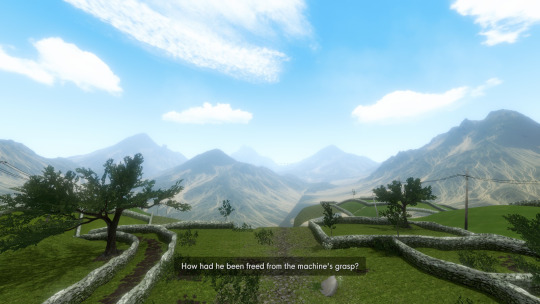
More saturated colours, some rock roads, trees, and mountains in the background - nature is ALIVE and well. Just like Stanley is, being freed, in Narrator’s eyes.
Because it is Narrator who chose to make this the end screen. It is just visible, time and time again, how much this man adores nature. Sure, he might be scared about the open world (next point, again) but he could have just remade the buildings from the original. But he chose not to - instead, upgrading it into something more beautiful.
This isn’t just an ending for Stanley - it’s an ending for HIM.
I think that’s why Memory Zone is just so similar, in my eyes, to Freedom in this aspect.
“(...) I made something special and tucked it away here where the game’s developers won’t find it.”

Some things do not match - the tree types seem different, the sky is a different colour, and small flowers pop here and there that aren’t in Freedom.
But there is a key element that does match - mountains.
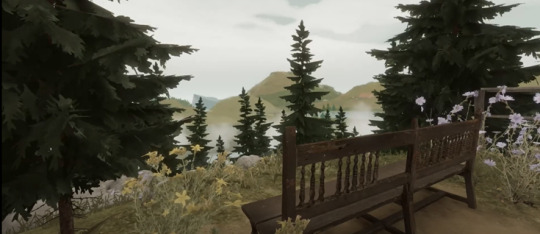
These two areas may be connected - Memory Zone seems to be on a higher standpoint, maybe on a hill rather than a mountain but due to just that, it is possible they are both connected, just in different parts of the world.
Memory Zone is special to Narrator - it is supposed to show his achievements and happiest moments. It would make sense that it was placed in a similar area as Freedom - just hidden so that the other game developers Narrator mentions, would not influence it.
The Maintenance area of the Memory Zone, however, is everything Narrator tried to repress. That is why he might not remember the reviews in there - it’s all hidden in his subconsciousness.

“I don’t recall this part of the Memory Zone before.”
Narrator had been probably working on the Memory Zone way before he shared it with Stanley. It was his safe space, or so he thought. The memory in the name seems to be the most important clue - it’s not like some remembering zone, history zone or something - it’s memory.
And memories like to get hazy.
As I mentioned - to me, Skip Button's room is a visual representation of Narrator’s mind, at least a part of it. And since it’s a part of this area - I headcanon the whole Memory Zone to be that.
Contrasting with the wild flora of the main Memory Zone, the maintenance seems very run down and secluded. The colours in Memory Zone are already desaturated in comparison to the rest of the game but this part looks dirty thanks to the focus on browns and greys. While some of the lovely nature is in there - birds, a big water pool, the trees are dead.
These dead trees, just like the Skip Button tree or 2011 Freedom Ending ones might be a pattern for Narrator when he is not in his best shape.


Once again, the game shows just how important the nature aspect seems in the key part of the story. Narrator made the conscious decision to change the Freedom Ending and probably also had some saying about the Memory Zone, until the parts he wanted to repress that got run down.
Narrator keeps on repressing things a lot throughout the game. He shows denial and shifts the blame - on Stanley, the Player or the reviewers. At the end of it all - during Skip - he finally realises his flaws and mistakes.
But that realisation happened way too late.
Maybe that’s why he later tries to separate himself from that Memory Zone, putting it in the Executive Toilet.

Or maybe, it’s some not-so-hidden poop joke. But that’s not as important.
So let’s get to the rest of the game.
5. “THE OFFICE COULD USE A BIT OF DECORATION.” (Other plants in-game, Games Ending, Epilogue)
Besides Fern, there is another plant that keeps on being with Stanley a lot. It is there, never in the foreground but it’s always there. It’s like a hidden companion - maybe, as a symbol for not so hidden one.
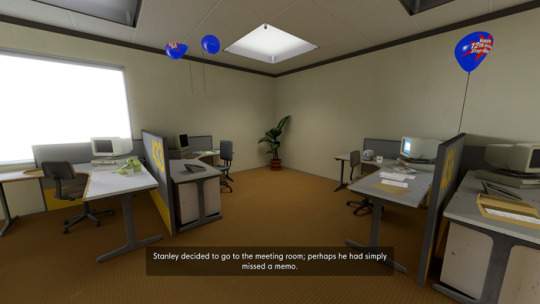
This plant shows up in most of the Left Door pathway to the Boss’s Office - 5 times in different rooms:
desks 431- 436,
desks 418-424,
left-right door choice,
Meetings Room,
and the entrance to Boss's office.
It also shows up in rooms we see around the pathway:
room with 456, 457 doors,
413 room,
Executive Bathroom
and two in the room with Elevator Music.
The plant shows up 4 times in Confusion Ending (including the earlier mentioned 456, 457 area)- and thinking how the Fern is also there makes me just feral. Narrator joins Stanley on his little adventure through the unknown territory - so he inserts himself in the story.

In the Right door pathway, we get through the first 3 from the Left door and 2 more - the Loungue and the Games Ending.
The Games Ending has very different alternations between the game version but one thing is stable - nature in the open words games.
“I wonder what he found.”
In 2011, once again, nature is quite dead and dried up. RIP all the plants in this version of the game.
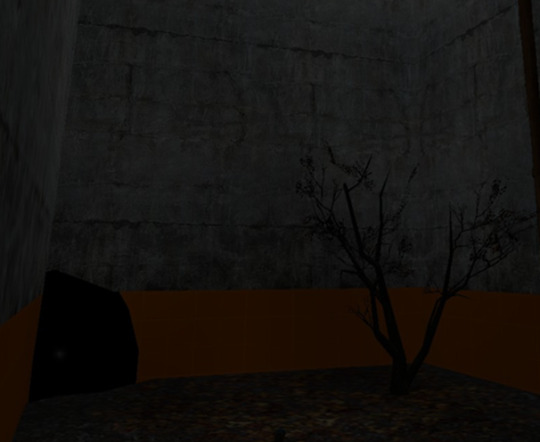
The next alternations, however, take a different approach and make the plants more alive.
The 2013 version uses Minecraft as it outdoor area.
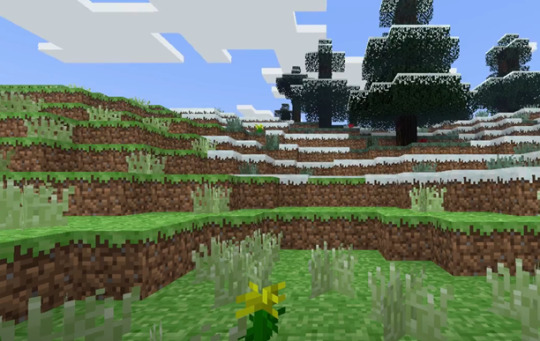
Narrator doesn’t focus at all on the nature aspect - more on the crafting one which is fair, he is a storyteller and a game designer.
In Ultra Deluxe, there are two areas - Rocket League and Firewatch.
Rocket League won’t get that much attention from me - it’s just a typical grass for sports fields.
The Firewatch, however, is a direct parallel with Minecraft. And it’s due to it being open-world.
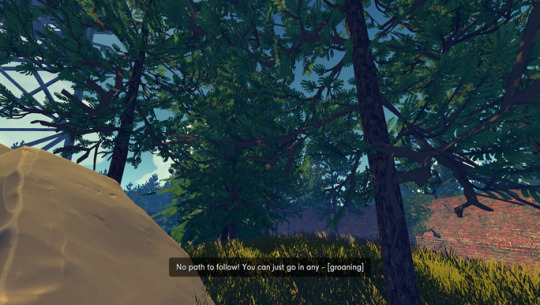
This brings me to the last issue with Narrator and nature - he likes it quite a lot, but it HAS to be limited for Stanley.
Freedom makes you stuck in a cutscene, you can only go to mines in Minecraft due to no jumps, Memozy Zone has barriers, so Stanley has one path to follow, and most plants are potted-
expect, for one thing.
And it’s the plants that show up in Skip #15.
I think it’s no coincidence that in the Bucket runs, the Red-Blue choice is off-limits. I think it’s due Narrator not wanting to go through things that hurt.
But they hurt not only him - they also hurt Stanley.
We could focus on the fact that each of the Games runs ends up with Stanley being trapped in the 2011 version.
But I think that lack of freedom to explore beyond the main area - the set path, the game, is what got Narrator more, in the end. Maybe he is scared about full freedom and lack of full control over the story and Stanley.
And maybe that’s why the Epilogue seems to be a never-ending desert. It’s Narrator’s last attempt to give Stanley the true freedom they both needed.
“An epilogue would be fun. Wouldn’t it, Stanley?”

(Shoutout to a Rammy who gave me the idea to talk about this screenshot.)
The desert, for me, fits the Sandman story (no, not just the song though now it is playing in my head so I hope it will play in yours, too). It shows up at the end of the Skip run and just like the room itself, I think it keeps on symbolising Narrator’s mind.
Once a mindflow, where his thoughts could drift anywhere they pleased became quite stagnant. He fell in hibernation or the mind was just no longer there.
The Sandman brought him the sand and let him rest, cope with the near eternity of solitude.
And to think, during it, Stanley uses wood he finds in this place to bring some light. Lighting up the neurons that still are active.
And this one last time a plant in any shape is present - it is there to serve Stanley.
Narrator, I see you. You probably never left because you are unable to but, you still care about Stanley.
And we care about you.
6. CONCLUSIONS

(painting in the background: The fairy grotto, 1867)
I could mention EVERY single plant in-game: all the nature paintings, plants in Demo and all the Infinitive Hole nature backgrounds, apple in Pink room, try to get through every plant and try to find its significance but at the end of the day-
this whole thing is over 3k words IOSFAIHOSAFHIOFSA
I know this post didn’t talk much about Fernator. I could talk about how Narrator’s need for control and being in a confined space makes him want to be in a Bucket that he also projects a lot onto. How plants often symbolise his psyche, show up in important parts of the office and as the only other visible living being besides Other Stanley and Mariella, maybe, just maybe, Narrator, who seems to not be human, might have decided to take such form, for comfort and safety. But I will leave that for another time.
So if you reached this point, I hope you realise that Fernator AU is a superior AU to the point it’s canon /silly/nsrs /j (,,,, or is it / silly)
If you are reading this - thank you so much for reading this ramble or just skimming through it. I do appreciate you.
Thank you and-
“I'm out... I'm out... I'm done! It's over! Thank you for playing! Your input was extremely valuable.”
#my ramblings#TSP#TSPUD#Ultra deluxe#Theory#The Stanley Parable#Plants#Bucket#Infinitive Hole#Fernator AU#Skip Button#Nature#theories#Epilogue#Adventure Line#Wife#Baby#Broom Closet#Confusion ending#bucket destroyer ending#memory zone#maintenance#cookie9#games ending#firewatch#minecraft#2011 mod
241 notes
·
View notes
Note
I just want to say a few things before you get to the end. First up, it's been a pleasure to read your thoughts on the series; like any fan, you have your own unique interpretations and it's always good to read how fans see certain scenes. It's also been fantastic to see fellow fans respond to your posts adding on to what you've written, again bringing your thoughts out more and generating discussion.
Also, seeing your thoughts has made me appreciate scenes and characters I never thought I would -- Yamamoto for instance, who would've thought?! They've also reminded me of why I fell in love with the series as much as I did, from the artwork to the themes to the incredible bonds between the characters. You've reminded me that BLEACH has it's flaws that can sometimes take you out of the story, but when it hits, it 100% HITS! It's a manga that's about the bonds we form, how they can help us overcome challenges and be a source of light in our lives. It's about the ways we overcome grief and the fear of death, whether it's literally fighting your way through it or slowly coming to a state of acceptance as time goes on. It's about the 'hearts' of people, about what they look like and how they're shared between those you choose. I could go on and on, but then this would become an essay and we'd be here all day.
All of this is to say, thank you for choosing to create a Tumblr account and deciding to read the series and give your thoughts along the way. I can't believe you've finally reached the end, it almost feels like I'm saying goodbye to the manga again!! I don't think I'm the only one here who sees you as a big and valued part of the community on here, so I hope you'll be sticking around! :)

Thank you so much Rays! Response under the cut because it went long.
This won't surprise you, but I too have grown in my appreciation for the series over the course of the uh three years that I've run this blog. Bleach has character concepts I've never seen elsewhere. It has moments of storytelling brilliance. It has truly, phenomenally astonishing art.
But more than anything else, I, like you, am impressed by the heart. For a story that's largely about the afterlife, Bleach is shockingly humanistic, locating virtue not in any system of belief, in any group or faction in the various conflicts that provide the setting for the manga, but in people. All people, whether they're our extremely relatable teenage protagonist and his friends, the occasionally sketchy adults in his life, or the various adversaries ranging from evil monsters to supernatural samurai to a regular-ass gang to a foreign apocalypse cult. Bleach never, not once, lets the viewer fall into the comfortable childish space of believing that there's good people and bad people in the world.
There's just people. Sometimes these people want to do bad things, like execute their sisters, or kidnap your girlfriend, or isolate you from your family, or destroy the entire world. Bleach doesn't flinch away from that either. But it (again, very humanistically) locates those bad actions not in the individual human beings, but in our relationships with one another through the systems and structures we've created to organize ourselves.
And yet in the face of the idea that humans do their worst work through other people, that's also where Bleach locates its greatest virtue. Alone, we're nothing. It's the bonds that we have with others that are what make life worth living, that are the source of everything good in this world. And navigating that dynamic, between spiritual bonds and structural shackles...that's really what adult life is all about, isn't it?
Anyhow, my adult life has been greatly enriched by all of you on here. But I'll take the chance to thank you specifically Rays, for being such a source of joy. Your positivity and passion are the sort of thing that makes a humble blogger want to come back for more, and I've deeply enjoyed hearing all of your thoughts, not just on my liveblog, but through your own posts and writing. I'll be sticking around for sure.
57 notes
·
View notes
Text
Are Game Blogs Uniquely Lost?
All this started with my looking for the old devlog of Storyteller. I know at some point it was linked from the blogroll on the Braid devlog. Then I tried to look at on old devlog of another game that is still available. The domain for Storyteller is still active. The devblog is gone.
I tried an old bookmark from an old PC (5 PCs ago, I think). It was a web site linked to pixel art and programming tutorials. Instead of linking to the pages directly, some links link led to a twitter threads by authors that collected their work posted on different sites. Some twitter threads are gone because the users were were suspended, or had deleted their accounts voluntarily. Others had deleted old tweets. There was no archive. I have often seen links accompanied by "Here's a thread where $AUTHOR lists all his writing on $TOPIC". I wonder if the sites are still there, and only the tweets are gone.
A lot of "games studies" around 2010 happened on blogs, not in journals. Games studies was online-first, HTML-first, with trackbacks, tags, RSS and comment sections. The work that was published in PDF form in journals and conference proceedings is still there. The blogs are gone. The comment sections are gone. Kill screen daily is gone.
I followed a link from critical-distance.com to a blog post. That blog is gone. The domain is for sale. In the Wayback Machine, I found the link. It pointed to the comment section of another blog. The other blog has removed its comment sections and excluded itself from the Wayback Machine.
I wonder if games stuff is uniquely lost. Many links to game reviews at big sites lead to "page not found", but when I search the game's name, I can find the review from back in 2004. The content is still there, the content management systems have been changed multiple times.
At least my favourite tumblr about game design has been saved in the Wayback Machine: Game Design Tips.
To make my point I could list more sites, more links, 404 but archived, or completely lost, but when I look at small sites, personal sites, blogs, or even forums, I wonder if this is just confirmation bias. There must be all this other content, all these other blogs and personal sites. I don't know about tutorials for knitting, travel blogs, stamp collecting, or recipe blogs. I usually save a print version of recipes to my Download folder.
Another big community is fan fiction. They are like modding, but for books, I think. I don't know if a lot of fan fiction is lost to bit rot and link rot either. What is on AO3 will probably endure, but a lot might have gone missing when communities fandom moved from livejournal to tumblr to twitter, or when blogs moved from Wordpress to Medium to Substack.
I have identified some risk factors:
Personal home pages made from static HTML can stay up for while if the owner meticulously catalogues and links to all their writing on other sites, and if the site covers a variety of interests and topics.
Personal blogs or content management systems are likely to lose content in a software upgrade or migration to a different host.
Writing is more likely to me lost when it's for-pay writing for a smaller for-profit outlet.
A cause for sudden "mass extinction" of content is the move between social networks, or the death of a whole platform. Links to MySpace, Google+, Diaspora, and LiveJournal give me mostly or entirely 404 pages.
In the gaming space, career changes or business closures often mean old content gets deleted. If an indie game is wildly successful, the intellectual property might ge acquired. If it flops, the domain will lapse. When development is finished, maybe the devlog is deleted. When somebody reviews games at first on Steam, then on a blog, and then for a big gaming mag, the Steam reviews might stay up, but the personal site is much more likely to get cleaned up. The same goes for blogging in general, and academia. The most stable kind of content is after hours hobbyist writing by somebody who has a stable and high-paying job outside of media, academia, or journalism.
The biggest risk factor for targeted deletion is controversy. Controversial, highly-discussed and disseminated posts are more likely to be deleted than purely informative ones, and their deletion is more likely to be noticed. If somebody starts a discussion, and then later there are hundreds of links all pointing back to the start, the deletion will hurt more and be more noticeable. The most at-risk posts are those that are supposed to be controversial within a small group, but go viral outside it, or the posts that are controversial within a small group, but then the author says something about politics that draws the attention of the Internet at large to their other writings.
The second biggest risk factor for deletion is probably usefulness combined with hosting costs. This could also be the streetlight effect at work, like in the paragraph above, but the more traffic something gets, the higher the hosting costs. Certain types of content are either hard to monetise, and cost a lot of money, or they can be monetised, so the free version is deliberately deleted.
The more tech-savvy users are, the more likely they are to link between different sites, abandon a blogging platform or social network for the next thing, try to consolidate their writings by deleting their old stuff and setting up their own site, only to let the domain lapse. The more tech-savvy users are, the more likely they are to mess with the HTML of their templates or try out different blogging software.
If content is spread between multiple sites, or if links link to social network posts that link to blog post with a comment that links to a reddit comment that links to a geocities page, any link could break. If content is consolidated in a forum, maybe Archive team could save all of it with some advance notice.
All this could mean that indie games/game design theory/pixel art resources are uniquely lost, and games studies/theory of games criticism/literary criticism applied to games are especially affected by link rot. The semi-professional, semi-hobbyist indie dev, the writer straddling the line between academic and reviewer, they seem the most affected. Artists who start out just doodling and posting their work, who then get hired to work on a game, their posts are deleted. GameFAQs stay online, Steam reviews stay online, but dev logs, forums and blog comment sections are lost.
Or maybe it's only confirmation bias. If I was into restoring old cars, or knitting, or collecting stamps, or any other thing I'd think that particular community is uniquely affected by link rot, and I'd have the bookmarks to prove it.
Figuring this out is important if we want to make predictions about the future of the small web, and about the viability of different efforts to get more people to contribute. We can't figure it out now, because we can't measure the ground truth of web sites that are already gone. Right now, the small web is mostly about the small web, not about stamp collecting or knitting. If we really manage to revitalise the small web, will it be like the small web of today except bigger, the web-1.0 of old, or will certain topics and communities be lost again?
55 notes
·
View notes
Text
I remember when game of thrones was first really getting popular and a fairly famous article was circulating about how part of the show’s success was down to the fact that it was doing “sociological storytelling,” as in it was telling a story about institutions and their power more than it was about any individual character. It was presented as a show about the force of history. And I feel like there is a similar comparison to be made with andor. It’s doing something unique with star wars. It presents the empire not as this apolitically evil government that needs to be destroyed because it loves to randomly kill people for fun, it shows you in excruciating detail how, exactly, the empire is bad. It shows you how violence is enacted upon people down to the administrative level - seemingly “neutral” processes like a government census are being used for oppressive ends, because an institution capable of large scale data collection on a population is also capable of large scale forms of brutality.
Andor feels like a show that engages with star wars at the level of its systems, and the story being told is about the horror of human beings confronting those systems and seeing just how quickly they can be completely robbed of their humanity. Cassian doesn’t just enter prison to commiserate with his fellow inmates; he is un-made as a person and is forced to become a piece of equipment that assembles parts of the imperial war machine. They never tell you what the prisoners are assembling in the show because it doesn’t matter. In fact, part of Cassian’s punishment is that he isn’t even being told what he’s building, alienating him entirely from the labour he’s being forced to provide for the empire. And he’s there because of completely made up charges, denied a trial or the right to even defend himself. The show is telling you that there is no escape from these kinds of institutions no matter how well behaved you think you’re being, that the rebels were not only morally justified but morally required to destroy the empire.
So I think ultimately part of why the show is so gripping is because Cassian’s fate almost feels like its out of the writers’ hands - the brutal logic of the imperial machine has completely hijacked his life in a dull, stupid, unglamorous way, unaware and uncaring that he is the main character of a heroic tale. This is a show that is still deeply character driven, but the forces that structure it are agnostic about any one person’s individual fates.
520 notes
·
View notes
Note
It's weird to think Vol 10 of RWBY just straight up might never happen. much less further volumes. No matter how bad it got I would still have loved some form of ending but Barabas comments don't paint a hopeful picture. Alas fics of RWBY will go until the end of time.
It's very weird. Most shows I come across have either already concluded, or give their audience an estimate of when things will wrap up ('We're planning another two seasons and each takes us about two years to film, so...'). I have shows that unexpectedly get more content after providing an ambiguous, but still satisfying ending (Alice in Borderland), shows where each season is self-contained so it can end whenever without issue (Bake Off), shows that were cut short and had to scramble to wrap up (Sense8), and of course there are always shows that are straight up cancelled and can't do a thing to mitigate that... but RWBY feels almost, almost unique in this combination. It's a webseries rather than a traditional TV show. It's gone on for a decade with absolutely no indication of where it's heading. Each season feels threatened to the point where the fandom can no longer differentiate between a real cancellation concern and Internet exaggeration. The story has hit what's arguably its most important narrative peak - the team has traversed an alternate world, Ruby has "overcome" drinking the tea, Summer finally appears on screen - only for news of the story's future to remain frustratingly vague. Not only have we never had a sense of when RWBY's story will end, now we don't even have confirmation of whether it will end. That's such a frustrating way to approach storytelling given that your audience relies on some level of commitment to remain engaged.
I too want RWBY to finish up because I am not immune to the Sunk Cost Fallacy: I put this much time into the series and it needs to satisfy me with a conclusion, even if the conclusion itself will inevitably be unsatisfying. Outside of any normal disappointment with a story you love getting the ax, I generally don't mind embracing unfinished works. I read abandoned fics, watch cancelled shows, browse barely started comics, because getting a taste of the world is always worth it if it's compelling to me. I never regret meeting characters whose stories go untold because as a writer myself I can at least imagine that on my own terms. But RWBY? Losing it now would be a real kick in the teeth. I personally don't think the story is salvageable at this point, but at the very least fans deserve a conclusion: one that will likely please a lot of devoted viewers and allow critical fans to put a satisfying tick mark on the box in our heads labeled "RWBY."
Given its popularity I wouldn't be surprised if RWBY wound up cancelled and then concluded in a comics run, or a one-off movie. Beyond the fact that this would no doubt mess up the writing even more (now you have to iron out this mess of a plot on a time limit, in a new medium, with new authors!) it would, unfortunately, be kind of hilarious too:
[generic tour guide voice]
"Hello. Welcome to RWBY. Our fandom is known for having copious side stories connected to the canon in confusing ways. Some are incidental to the main series. Some outright contradict it. Some are crucial to your understanding of the primary plot and must be engaged with in a timely manner. These texts range from comic runs to random bits of information in abandoned mobile games. Please note that this corpus did not grow naturally across decades of storytelling, as is the case with fandoms like Star Trek and Star Wars, but was rather cobbled together by RT in an attempt to 'fix' numerous, ongoing issues with the webseries.
Our latest addition? The ending. Yes, if you would like to finish RWBY please refer to this index of sources that together provide a semi-cohesive conclusion to a ten year show.
Now, on your left you'll see the ongoing brawl as fans attempt to determine whether this index is canonical or not. Please watch your step..."
58 notes
·
View notes
Text
..............................
The Coffin of Andy And Leyley = Should We Really Care About the Incest?
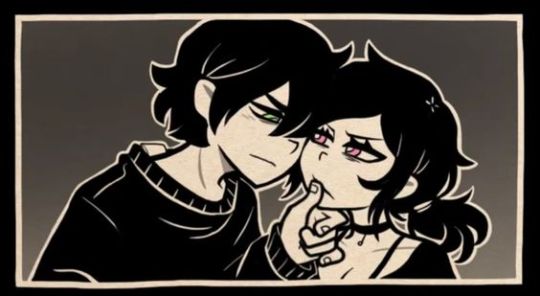
Plot Summary: A water contamination scheme keeps the brother-sister duo, Andrew and Ashely Graves, locked in their apartment on the verge of starvation. They discover a way out through demonic shenangians.
Can these two grow past their childhood identities? Or are they destined to be each other's demise?
..............................
Overall Thoughts
*Warning* These are my thoughts. Do not take them seriously. You can disagree all you want in the comments below. Enjoy!
First hearing about The Coffin of Andy and Leyley left a sour taste in my mouth. And it's probably for the same reason most people refuse to engage with the story being told by creator Nemlei. The notion on Twitter (or X, ew) dubbed this media as just the 'incest' game unfairly and failed to appreciate the themes being showcased by the siblings.
I believe that The Coffin of Andy and Leyley will grow in popularity by the release of the third episode. And this game will be a cult classic in no time, setting new records for storytelling in future indie projects.
I deep-dived into Nemlei's gameography, and dare I say, those other projects walked so Andrew and Leyley could run. There's only praise that should be afforded to Nemlei based on their improvements.
Watch or play through No-Good Noelle, which had come out three months prior, and see the differences. I also recommend Divilethion for those yearning for Nemlei's storytelling/art style.
But what those two games have in common, is that there's less to do for the players. While Andy and Leyley have the mechanics within its gameplay to be 10x more interactive for audiences. No wonder it had grown in popularity.
Now, to address the incest.
You do not have to like taboo topics. You do not have to engage with media that showcase it or be a part of a hate campaign because you don't like something. And as a society, we should bring awareness to media forms that encourage/promote dangerous ideology. Which in most cases does include incest.
However, art forms can get away with handling these taboo topics because they turn them into tools for driving a theme forward. And they aren't inherently romanticizing dangerous ideals. With that said it can be tricky for creators to handle these topics with care. You can hold the opinion that The Coffin of Andy and Leyley didn't utilize the concept of incest effectively in its narrative.
But, most people who've 'criticized' the game, dog pilled it because of the incest without understanding its importance to the themes. I get it, okay. It's disgusting that these siblings are down to bone.
Yet, as a writer, Andrew and Ashely are stellar characters with unique relationship dynamics. The theme of codependency is heightened by the pair's familial ties. Here's a little exercise:
Imagine Andrew and Ashely weren't siblings... They become slightly less interesting. Mainly due to the fact, they cannot uphold their OG purpose.
Episode two has two endings, Decay and Burial. Both hinges on the siblings making a choice to either let the past go or hold onto Andy and Leyley, their childhood nickname, now a source of resentment. Ashely idolizes the past while Andrew strives towards the future. On paper, they are foils of one another. These characters can work while not being related.
They could've been childhood friends if Nemlei wanted. But, then the plot would need to change.
Episode 2 wouldn't have worked to flesh out these characters equally because it was a murder scheme against their parents. Both Andrew and Ashely's interaction with their mother and how the events of the murder played out, heightened the themes of willingness to change or the lack of. And subsequentially, the codependency of the siblings.
At the end of the day, creators should be encouraged and pushed to create narratives through uncomfortable lenses. Sometimes a story can only stand out with that unique perspective. Nemlei's rap sheet as a game developer has never been taboo-free, however, it was this game that got them hated, bullied, and doxed.
Because of implied incest -from what I'm concerned. Aside from the dream stuff.
I'm not shocked, just disappointed that people took to the internet to be hateful about a game with merit.
I hope Nemlei takes this in stride and comes back to the platform with the release of episode 3. I am in love with The Coffin of Andy and Leyley. There are many unanswered questions. And I can only see a bittersweet ending for these characters.
Join me next time, when I give my thoughts on Andrew and Ashely Graves. I will deep dive into episodes 1 and 2 as well in the future.
⚰️🔪⚰️🔪⚰️🔪
Thoughts on Ashely Graves:

LOADING.....
⚰️🔪⚰️🔪⚰️🔪
Thoughts on Andrew Graves:
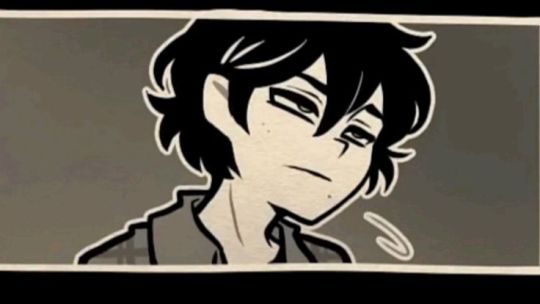
LOADING.....
..............................
Check out my master list where you'll be able to find more rant content; here.
Future fanfics are in the works so follow me. 🥹
I recommend checking out my character thought pieces on Okazaki Kei and Shiraishi Kageyuki from Collar X Malice.
>>>
NEXT COFFIN POST:
Andrew and Ashely Character Thought Pieces
#second.thoughts#the coffin of andy and leyley#Andrew and Ashely Graves#andrew graves#ashely graves#critisim#nemlei#provoking thoughts#opinion post#gravecest#just ew incest bad therefore game bad and creator evil!!
27 notes
·
View notes
Text
The Isles is Particularly Awful for Sequel/Next Gen Stories
With Belos gone, the Isles loses literally the only thing that makes it unique from any generic fantasy setting out there: The Coven System. Worse yet is how much the show tries to blame every bad thing on the Isles on Belos and his collaborators, portraying pre-Belos as utopian, so now that he's gone, you have to retcon that part of the show to have ANY real threats.
That's really the main thrust of this. I could expand but the basic point is that there's just nothing to do with the Isles that's better than doing it during Belos' reign. You could explore the Isles but now you're just messing with monsters in their ecosystem who were never a real threat in the show. You could try to depict the reconstruction but there's no tension between people of the Isles, just a need to rebuild. Besides, how do you even portray that when the Isles has zero culture so there's nothing to explore in how they are besides how they feel about Belos falling which is seen as a positive by EVERYONE if the group shot at the end, where even old enemies are now on Luz's side, is any indication.
Really, the only thing about the Isles that is still intact in a way that makes for interesting storytelling AT ALL is Hexside and pretty much just because it's a generic fantasy school that you can do whatever you want with. Which... Yeah, that's pretty much all I've seen. Despite the fact that the fandom immediately went for fankids after the finale, no one seems to have anything to do with them besides throwing out concepts and shipping. Or, you know, recycling old plot lines but with the new cast, committing the cardinal sin of next gen stories of just having an excuse to reset and retell. *glares at Boruto*
But what else are you supposed to do? Unless you want to say Eda and Raine failed in reforming the Isles, you have no conflict there. You either have to bring back old villains, bring in an invading force, both... Or change things so drastically that I question why you're not just doing an original story since you're having to put in that much work anyways.
I guess MAYBE you could do the Isles integrating with humans but like... The show made it clear that that's not a hard process either direction. And why should it be? The Isles is so generic as to barely feel like the other world that it is instead of just our world but with elves.
Even Amphibia, which ends similarly happy, still gives people more to do simply by the fact that it explored its setting. There's still so much out there. The three races still have to figure out how to coexist. Andrias wasn't a toxic power structure, he was THE power structure and the entire world has to recover from an incredible ecological disaster instead of just a glitter bomb.
So yeah, good on those who are having fun with their fan kids but I'll just continue to hope they don't try to continue TOH, not when they left themselves nowhere to go.
======+++++======
I have a public Discord for any and all who want to join!
I also have an Amazon page for all of my original works in various forms of character focused romances from cute, teenage romance to erotica series of my past.
I have an Ao3 for my fanfiction projects as well if that catches your fancy instead.
If you want to hang out with me, I stream from time to time and love to chat with chat.
A Twitter you can follow too
And a Kofi if you like what I do and want to help out with the fact that disability doesn’t pay much.
49 notes
·
View notes